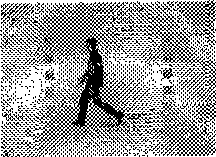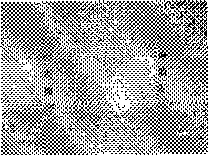Partitioned matrix-based gait recognition method
A block matrix and gait recognition technology, applied in the field of pattern recognition, can solve the problems of unsimplified feature extraction, low recognition accuracy, and huge data volume, and achieve the effect of improving recognition speed, recognition accuracy, and recognition accuracy
- Summary
- Abstract
- Description
- Claims
- Application Information
AI Technical Summary
Problems solved by technology
Method used
Image
Examples
Embodiment Construction
[0033] The present invention is described in more detail below in conjunction with accompanying drawing example:
[0034] 1. In order to extract the human target, first extract a single frame image from the original video for grayscale transformation (as shown in Figure 2(a)); then calculate the median value of each pixel in frame by frame as the background image of the entire sequence (as shown in Figure 2(b)); finally, the background subtraction method is used to extract the human body target (as shown in Figure 2(c)), and mathematical morphology is used to fill the holes in the binarized image, and simple connectivity analysis is used to extract the silhouette of the person (as shown in Figure 2 (d)). In order to eliminate the influence of image size on recognition, the human body should be centered, and the image size should be unified to 64*64 pixels (as shown in Figure 2(e)).
[0035] 2. Periodic detection of gait
[0036] image 3 To explain the positioning of the ell...
PUM
 Login to View More
Login to View More Abstract
Description
Claims
Application Information
 Login to View More
Login to View More - R&D
- Intellectual Property
- Life Sciences
- Materials
- Tech Scout
- Unparalleled Data Quality
- Higher Quality Content
- 60% Fewer Hallucinations
Browse by: Latest US Patents, China's latest patents, Technical Efficacy Thesaurus, Application Domain, Technology Topic, Popular Technical Reports.
© 2025 PatSnap. All rights reserved.Legal|Privacy policy|Modern Slavery Act Transparency Statement|Sitemap|About US| Contact US: help@patsnap.com



